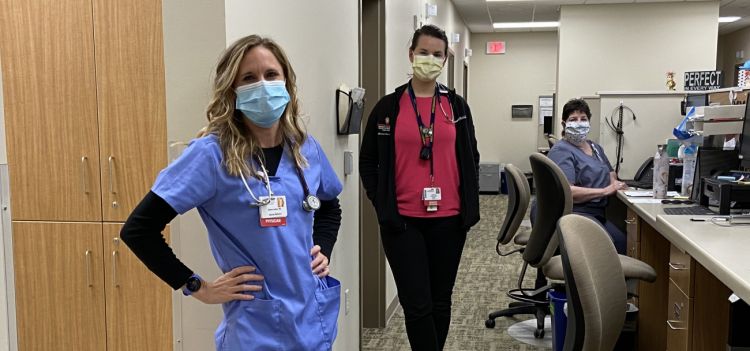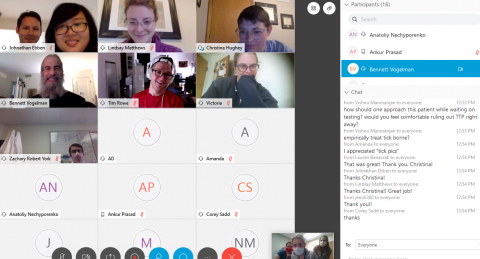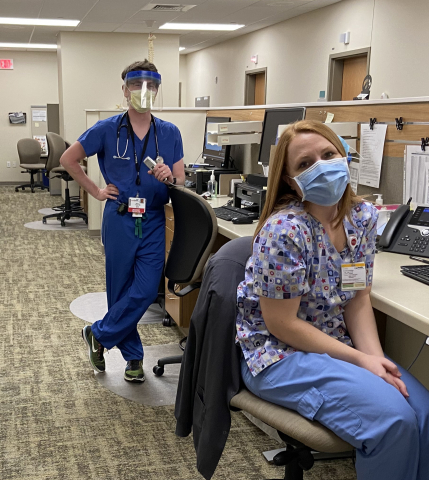Internal medicine residency leaders, learners take on the COVID-19 challenge

The internal medicine residency program at the University of Wisconsin Department of Medicine has worked nimbly to ensure that its physicians in training receive the best possible educational experience during the COVID-19 pandemic.
While program leaders have effectively reorganized many curricular components and clinical experiences in a matter of weeks, residents have universally stepped up to support patient care needs and each other—and discovered new learning opportunities along the way.
Teaching in the era of remote work
Social distancing presents a challenge to one of the mainstays of a residency program’s curriculum: the in-person conference.
Under the leadership of Amy Zelenski, PhD, associate program director and the program’s director of education scholarship, residents in the TEACH pathway, which focuses on training physician-educators, quickly brought morning reports, journal clubs and faculty presentations online. They continue to transform other parts of the didactic curriculum to a virtual format for the duration of the pandemic.
To help residents stay informed and connected in this new environment, Jeremy Smith, MD, associate program director and the program’s director of education development and systematic literature review projects, created a weekly COVID-19 email update.
In addition, Bennett Vogelman, MD, residency program director and the department’s vice chair for education, holds weekly town halls for everyone in the program. “He answers every single question we ask and provides real-time updates on things that are rapidly changing,” notes resident Stephanie Pritzl, MD.

Above: internal medicine residents participate in a “virtual” morning report with program director Bennett Vogelman, MD (second row, left). Credit: Caitlin Peirce, MD.
New clinical learning experiences
With support from program leaders, residents are learning innovative ways to meet patient care needs under extraordinary circumstances.
In outpatient clinics
For example, a centralized team of residents now provides care for patients who would normally see a specific internal medicine resident for their primary care needs. The team covers in-person and telemedicine visits, COVID-19 triage, patient communication and prescription refills.
“This organizational change helps the residents who have new inpatient duties due to COVID-19 not feel torn between inpatient and outpatient care,” notes Trowbridge Endowed Primary Care Chief Resident Caitlin Peirce, MD. “We think it can also help inpatients and outpatients alike get better care.”
“This rotation has given residents an appreciation for what a typical day is like for an outpatient physician,” adds Kelly Lavin, MD, associate program director and director of the residency’s primary care track, who also provided direct telemedicine training to residents. “It’s teaching them how to be flexible, and preparing them for skills they will need in their careers.”

Above: internal medicine resident Matthew Folstad, MD, in the outpatient clinic with medical assistant Emily Steuber. Credit: Caitlin Peirce, MD.
In the hospital
Similarly, the program has restructured most of its inpatient resident rotations to meet the needs of a COVID-19 surge. Bridges Family Endowed Chief Resident Matthew Caldis, MD, has led that charge by developing new schedules and team structures, so residents can be quickly deployed to inpatient settings as needed.
“Dr. Caldis has been way ahead of the curve at identifying ways to be responsive to resident needs as well as the needs of our patients,” notes Sean O’Neill, MD, associate program director and the program’s director of evidence-based medicine curriculum. “And the residents have really put themselves out there,” he adds.
Matthew Brunner, MD, a residency alumnus who is now a Hematology and Medical Oncology fellow, has also led a group of residents, fellows and faculty in the development of curricular materials for the care of COVID-19 patients. They’re sharing these resources with learners or providers who may be redeployed during a surge.
Similarly, at the William S. Middleton Veterans Hospital, two associate program directors—Christopher Hildebrand, MD, associate chief of staff for ambulatory care and education; Veterans Hospital; and Robert Holland, MD, director of resident performance improvement, QI and interprofessional curriculum, restructured schedules so residents could assist with a surge in COVID-19 patients. There, they work closely with Christopher Crnich, MD, PhD, associate professor, Infectious Disease, and chief of medicine and hospital epidemiologist at the VA, who established a COVID-19 service at the VA.
In the intensive care unit
Covering the COVID-19 intensive care unit has been another valuable, yet challenging, part of the learning experience. Working as part of an integrated team of faculty physicians, nurses and respiratory therapists has taught residents innovative ways to care for the sickest COVID-19 patients.
Timothy Rowe, MD, a third-year resident who plans to pursue a career in pulmonology and critical care, was one of the first to opt in to this service. Despite the work’s emotional toll, he says being involved in the early days of COVID-19 critical care is both valuable and rewarding.
“I am continually floored by the talent, innovation, and selflessness of all members of the incident command team, as well as the front-line healthcare workers,” he reflects. “It is a very tangible reminder of the incredible talent and integrity that we are surrounded with on a daily basis.”
Supporting each other professionally and personally
Internal medicine residents are already a collegial group, but it seems the COVID-19 crisis has brought them even closer together.
Some have taken on additional clinical work, or offered personal help such as babysitting or housecleaning, for their colleagues.
And several are participating in a new UW Health peer-support program that aims to bolster resiliency and well-being among colleagues who may be struggling with the emotional impact of their work.
One of the leaders of this program, Mariah Quinn, MD, MPH, associate program director and director of humanism in medicine curriculum and wellness, has also been conducting regular check-ins with residents. She and the program’s wellness committee have also been providing residents with many resources for self-care.
In the face of the unprecedented experience of the COVID-19 pandemic, it’s clear that the program’s responsiveness and support has empowered residents to step up in the best possible ways.
“There’s no other place I’d want to be training right now than here at UW,” says Pritzl. “The way that things are being handled is just remarkable.”
Banner, from left: Briana Jelenc, MD, clinical assistant professor, General Internal Medicine, in the clinic with internal medicine resident Johanna Poterala, MD, and medical assistant Kathy Coppens. Credit: Caitlin Peirce, MD.